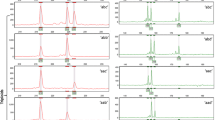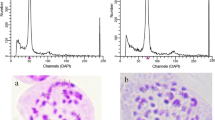Abstract
Marker transmission ratio distortion (TRD) revealed in genetic mapping studies on distant crosses can be used to infer the genetic basis relating to reproductive barriers between species. Unlike measuring the degree of TRD by the overall number of segregation distorted markers in the affected genome regions, mapping the segregation distorting loci (SDL) provides reliable statistic parameters that help to confine the target genomic regions for further characterization at molecular level. Using the linkage map constructed for a natural hybrid of Pinus hwangshanensis and Pinus massoniana, we perform SDL analyses and align the established map to the loblolly pine consensus map. Altogether, six SDLs with relatively strong LOD supports are detected on four linkage groups of the established map. Since gametes inheriting different alternate chromatid blocks from the SDL affecting genome regions have uneven chance to descend to the offspring, the corresponding genome regions are supposed to play more significant roles in rendering the reproductive isolations between P. hwangshanensis and P. massoniana. This paper presents a case study on a crucial step for uncovering the hidden genetic factors that trigger the uneven descending of gametes in a natural hybrid pine.

Similar content being viewed by others
References
Albert TJ, Molla MN, Muzny DM et al (2007) Direct selection of human genomic loci by microarray hybridization. Nat Methods 4:903–905
Alheit KV, Reif JC, Maurer HP, Hahn V, Weissmann EA, Miedaner T, Würschum T (2011) Detection of segregation distortion loci in triticale(x Triticosecale Wittmack) based on a high-density DArT marker consensus genetic linkage map. BMC Genomics 12:380
Carr DE, Dudash MR (2003) Recent approaches into the genetic basis of inbreeding depression in plants. Philos Trans R Soc Lond B Biol Sci 358:1071–1084
Causse MA, Fulton TM, Cho YG et al (1994) Saturated molecular map of the rice genome based on an interspecific backcross population. Genetics 138:1251–1274
Fishman L, Kelly A, Morgan E, Willis JH (2001) A genetic map in the Mimulus guttatus species complex reveals transmission ratio distortion due to heterospecific interactions. Genetics 159:1701–1716
Gernandt DS, Lopez GG, Garcia SO, Liston A (2005) Phylogeny and classification of Pinus. Taxon 54:29–42
Greig D (2009) Reproductive isolation in Saccharomyces. Heredity 102:39–44
Hall MC, Willis JH (2005) Transmission ratio distortion in intraspecific hybrids of Mimulus guttatus: implications for genetic divergence. Genetics 170:375–386
Harushima Y, Nakagahra M, Yano M, Sasaki T, Kurata N (2001) A genome-wide survey of reproductive barriers in an intraspecific hybrid. Genetics 159:883–892
Hu ZQ, Xu S (2009) PROC QTL—a SAS procedure for mapping quantitative trait loci. International J Plant Genomics. doi:10.1155/2009/141234
Jenczewski E, Gherardi M, Bonnin I et al (1997) Insight on segregation distortions in two intraspecific crosses between annual species of Medicago (Leguminosae). Theor Appl Genet 94:682–691
Jiang CX, Chee PW, Draye X, Morrell PL, Smith CW, Paterson AH (2000) Multilocus interactions restrict gene introgression in interspecific populations of polyploid Gossypium (Cotton). Evol 54:798–814
Kocher TD, Lee WJ, Sobolewska H, Penman D, McAndrew B (1998) A genetic linkage map of a cichlid fish, the tilapia (Oreochromis niloticus). Genetics 148:1225–1232
Kulmunia J, Seifertb B, Pamiloc P (2010) Segregation distortion causes large-scale differences between male and female genomes in hybrid ants. Proc Natl Acad Sci USA 107:7371–7376
Li L, Guo X (2004) AFLP-based genetic linkage maps of the Pacific oyster Crassostrea gigas Thunberg. Mar Biotechnol 6:26–36
Li SX, Chen Y, Gao HD, Yin TM (2010) Potential chromosomal introgression barriers revealed by linkage analysis in a hybrid of Pinus massoniana and P. hwangshanensis. BMC Plant Biol 10:37
Luo L, Xu S (2003) Mapping viability loci using molecular markers. Heredity 90:459–467
Luo SJ, Zou HY (2001) Study on the introgressive hybridization between Pinus hwangshanensis and P. massoniana. Sci Sil Sin 37:118–122
Luo L, Zhang YM, Xu S (2005) A quantitative genetics model for viability selection. Heredity 94:347–355
Martinsen GD, Whitham TG, Turek RJ, Keim P (2001) Hybrid populations selectively filter gene introgression between species. Evol 55:1325–1335
Moyle LC, Graham EB (2006) Genome-wide associations between hybrid sterility QTL and marker transmission ratio distortion. Mol Biol Evol 23:973–980
Myburg AA, Vogl C, Griffen AR, Sederoff RR, Whetten RW (2004) Genetics of postzygotic isolation in Eucalyptus: whole-genome analysis of barriers to introgression in a wide interspecific cross of Eucalyptus grandis and E. globulus. Genetics 166:1405–1418
Orr HA, Turelli M (2001) The evolution of postzygotic isolation: accumulating Dobzhansky-Muller incompatibilities. Evol 55:1085–1094
Payseur BA, Nachman MW (2005) The genomics of speciation: investigating the molecular correlates of X chromosome introgression across the hybrid zone between Mus domesticus and Mus musculus. Biol J Lin Soc 84:523–534
Rieseberg LH, Linder CR, Seiler GJ (1995) Chromosomal and genic barriers to introgression in Helianthus. Genetics 141:1163–1171
Rieseberg LH, Baird SJE, Gardner KA (2000) Hybridization, introgression, and linkage evolution. Plant Mol Biol 42:205–224
Sewell MM, Sherman BK, Neale DB (1999) A consensus map for loblolly pine (Pinus taeda L.). I. Construction and integration of individual linkage maps from two outbred three-generation pedigrees. Genetics 151:321–330
Taylor DR, Ingvarsson PK (2003) Common features of segregation distortion in plants and animals. Genetica 117:27–35
Temesgen B, Brown GR, Harry DE, Kinlaw CS, Sewell MM, Neale DB (2001) Genetic mapping of expressed sequence tag polymorphism (ESTP) markers in loblolly pine (Pinus taeda L.). Theor Appl Genet 102:664–675
Tuskan GA, Difazio S, Jansson S et al (2006) The genome of black cottonwood, Populus trichocarpa (Torr. & Gray ex Brayshaw). Science 313:1596–1604
Van Ooijen JW, Voorrips RE (2001) JoinMap 3.0, Software for the calculation of genetic linkage maps. Plant Research International, Wageningen, The Netherlands
Vogl C, Xu S (2000) Multipoint mapping of viability and segregation distorting loci using molecular markers. Genetics 155:1439–1447
Voorrips RE (2006) MapChart 2.2: software for the graphical presentation of linkage maps and QTLs. Plant Research International, Wageningen, The Netherlands
Wang B, Porter AH (2004) An AFLP-based interspecific linkage map of sympatric, hybridizing Colias butterflies. Genetics 168:215–225
Wang XR, Tsumura Y, Yoshimaru H, Nagasaka K, Szmidt AE (1999) Phylogenetic relationships of Eurasian pines (Pinus, Pinaceae) based on chloroplast rbcL, matK, rpl20-rps18 spacer, and trnV intron sequences. Amer J Bot 86:1742–1753
Wu ZY (1980) Vegetation in China. Science, Beijing
Xing YH, Fang YX, Wu GR (1992) The preliminary study on natural hybridization between Pinus hwangshanensis and P. massoniana in Dabie Mountain of Anhui Province. J Anhui For Sci Tech 4:5–9
Xu S (2008) Quantitative trait locus mapping can benefit from segregation distortion. Genetics 180:2201–2208
Yin TM, Li D, Chen Y, Huang MR, Wang MX (2004a) Preliminary detection of polymorphisms of expressed sequence tag in Pinus massoniana. Act Sil Sin 40:176–180
Yin TM, Difazio SP, Gunter LE, Riemenschneider D, Tuskan GA (2004b) Large-scale heterospecific segregation distortion in Populus revealed by a dense genetic map. Theor Appl Genet 109:451–463
Zamir D, Tadmore Y (1986) Unequal segregation of nuclear genes in plants. Bot Gaz 147:355–358
Zhou YF, Abbott RJ, Jiang ZY, Du FK, Milne RI, Liu JQ (2010) Gene flow and species delimitation: a case study of two pine species with overlapping distributions in Southeast China. Evolution 64:2342–52
Zhu CS, Zhang YM (2007) An EM algorithm for mapping segregation distortion loci. BMC Genet 8:82
Acknowledgments
We thank Dr J. Armento in Oak Ridge, Tennessee, USA for his comments and editing for this manuscript, and special thanks go to the editor and anonymous reviewers for their help in formulating the revisions. Funding for this work was provided by 948 project (2012-4-41), 973 project (2012CB114505), and the Natural Science Foundation of China (31125008, 31070543). It is also funded by the Doctorate Fellowship Foundation and PAPD program at Nanjing Forestry University.
Author information
Authors and Affiliations
Corresponding author
Additional information
Communicated by P. Ingvarsson
Shuxian Li and Zaixiang Tang contribute equally to this work.
Electronic supplementary material
Below is the link to the electronic supplementary material.
Supplemental Table 1
Pine EST primer pairs adopted from a paper of Temesgen et al. (2001) for map alignment in this study (DOC 109 kb)
Supplemental Fig. 1
The linkage map integrated with EST markers for a natural hybrid of P. massoniana and P. hwangshanensis. In this figure, the linkage group identity is listed on top of each linkage group. This map is aligned to the pine consensus map by integrating EST markers selected from the loblolly pine consensus map (Temesgen et al. 2001). The linkage group identities started with “chrom” are named after the designations as that reported in the paper of Temesgen et al. (2001), whereas linkage group identities started with “LG” represent groups that were not aligned to the loblolly pine consensus map. EST markers are in italic bold fonts. Marker with name ending with an “r” is in repulsion linkage phase. “+” and “++” following a marker name show that segregation distortion skews to more visible allele of the corresponding marker at significance level of p ≤ 0.05 and p ≤ 0.01. Whereas “−” and “−−” show that segregation distortion skews to more invisible allele of the corresponding marker at significance level of p ≤ 0.05 and p ≤ 0.01 (PPT 255 kb)
Rights and permissions
About this article
Cite this article
Li, S., Tang, Z., Zhang, D. et al. Genome-wide detection of genetic loci triggering uneven descending of gametes from a natural hybrid pine. Tree Genetics & Genomes 8, 1371–1377 (2012). https://doi.org/10.1007/s11295-012-0524-5
Received:
Revised:
Accepted:
Published:
Issue Date:
DOI: https://doi.org/10.1007/s11295-012-0524-5




